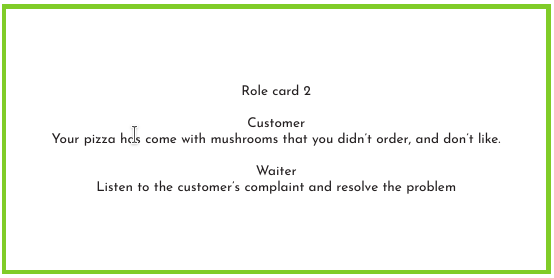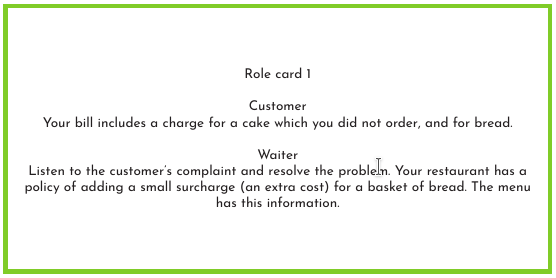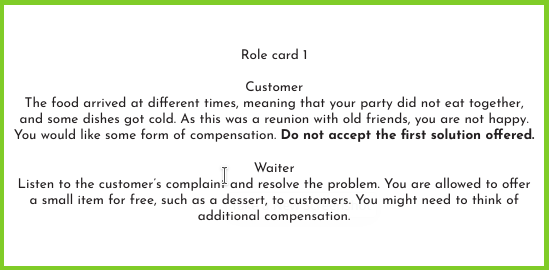Which principles guide the creation of effective materials to support language learning? This is the main question we address on Module 4 of our course on Task-Based Language Teaching (TBLT), which is now open for registration.
Broadly speaking, we can divide TBLT materials into two distinct camps: those which support productive tasks, and those based on input.
Materials to support productive tasks in TBLT
As one of the key goals in TBLT is to foster genuine communication between learners, this type of material should, with the minimum of fuss, prompt, promote and extend that communication. Here, suitable materials may include:
- Role cards
- Writing templates and frames
- Forms – both to be completed as written texts in themselves, or filled in with details from a discussion or problem-solving task
- Surveys and questionnaires
- Texts to be discussed, compared or analysed
- Images to be described, mainpulated, arranged, reminisced about …
Frankly, anything relevant to the performance of a productive task in real life can be translated into a piece of material. If your students are computing science undergraduates and will need to do product demos in their professional lives, we’d naturally want them to practise this with a piece of software — either something the students have already made, an existing product they are familiar with, or an imaginary one with certain key features to be explained.
We can also build a simple-to-complex progression into our material design which reflects the interest in TBLT in manipulating cognitive rather than linguistic features of tasks in order to push language development.
Here are some role cards for trainee waiters produced as part of the TBL4Tourism project. The target task here is Dealing with a complaint.

What, mushrooms? Yummy! But let’s imagine we don’t like them.
This should be fairly straightforward to resolve. There’s one element to the complaint, and probably just one or two possible solutions to consider: remove the mushrooms, or if the client insists, provide a whole new shroom-free pizza.
Students could be additionally guided here by having a restaurant policy document to inform the negotiation of the solution.

Here, the restaurant policy on bread is included in the card and will need to be explained. Let’s hope the customer is happy with that.
But what about the cake?
Here a successful solution may involve identifying and acknowledging the error, offering an apology, and explaining the action to be taken.
A little more challenging than mushroomgate – so correspondingly this version of the task requires more linguistic resources and pragmatic skills.

Oh no! Here there are more elements to deal with, and this client is going to be more tricky to placate. It might take a free dessert and a chupito (a little shot of liquor) if we’re in Spain …
Or maybe the customer is going to look for a discount. We might need to consult a higher authority!
In any case, this version of the task should push negotiation skills and require more complex and precise linguistic resources to resolve it.
One possible issue with these materials is that there’s too much information. The learner is likely to be led by the text on the card, so if a form such as ‘I would like’ is given to them, they could just use it without having to make a choice.
We could strip the information to its bare bones, like this:
Client
- You are in a group of old friends
- Your orders arrived at different times. Some dishes were cold
- You are unhappy and want compensation
- Do not accept the first offer
Waiter
- The service was chaotic – staffing issues – give an explanation
- Restaurant policy: a small item free (e.g. dessert)
- Further compensation – check with manager
In this case, the students have more freedom to resolve the complaint. Complexity is also increased by the need for the waiter to explain the problem, and to refer to a third party (maybe the teacher or another student) to help negotiate a solution.
In addition, both parties could be given a few minutes time to plan their strategy, which may result in more complex or precise language being produced; on the other hand, reducing or eliminating this may push students to use their current linguistic resources with more fluency.
The intertextuality of task-based materials
What the last example demonstrates is that materials for productive tasks are often intertextual — that is, many tasks depend on reference to one or more textual sources in order to be resolved.
In the case of our role cards, the text is an artificial intrusion on the part of the task designer in order to facilitate the dialogue. In other cases, such as a task from the same syllabus where waiters present a menu to diners, we would find the text being used in the target task in real life.
What happens, however, when we want to create tasks which focus only on receptive skills — either because the task itself is purely receptive, or because we want to expose students to relevant input before they embark on the productive phase of a task?
Optimising input in task-based materials
The idea of optimising input in task-based teaching lies at the heart of our module on material design.
Michael Long (2020) described four way of treating the input we provide students. In this we have to keep in mind two of Long’s key methodological principles for language teaching: providing rich input, and elaborating the input we provide (Long 2015).
Genuine (authentic) input
If input for pedagogic tasks is carefully selected from a real life — a recording of a successfully resolved complaint dialogue between a client and a waiter, for example — it will have the big advantage of being rich, that’s to say, full of relevant discourse for the students to notice or work on.
As Long says:
If [students] are to be prepared to achieve their context-, domain-, and task-specific communicative needs beyond the classroom, they require materials that expose them to samples of the L2 that are context-, domain-, and task-specific, especially, but not only, if advanced functional proficiency is the goal.
Long 2015, p. 307
However, there are two issues. Firstly, a single authentic example is unlikely to have adequate coverage of all the typical discourse features of the task.
Secondly, “[t]he obvious problem is that, except when employed with very advanced students, genuine texts will be linguistically overwhelming and usually constitute psycholinguistically inappropriate input for language learning” (Long 2020, p. 2).
So what about …
Simplified input?
Here we have the opposite problem. Simplified input is less likely to pose comprehension difficulties, but correspondingly will lose its richness. Simplified input is, for Long, impoverished input. It is typically used as a vehicle in textbooks to teach seeded grammar items, an approach which is substantially at odds with task-based and other communicative approaches to language learning.
Elaborated and elaborated-modified input
This is the key solution that Long suggests.
Input which has been elaborated loses none of its richness, but its comprehensibility is improved by the addition of redundancy and other compensatory devices. Long’s example of a genuine sentence:
-
The only witness just caught a glimpse of the driver as he fled the scene, so she could only provide the police with a rough description.
… becomes, in its elaborated version:
- The only person who saw the accident, the only witness, was a woman. She only caught a glimpse of the driver, just saw him for a moment, because he fled the scene, driving away fast without stopping, so she could only provide the police with a rough description of him, not an accurate one.
The final step is to reduce sentence length and add linking expressions to further support the reader. This is the elaborated-modified version:
- The only person who saw the accident, the only witness, was a woman. She only caught a
glimpse of the driver, just saw him for a moment, because he fled the scene, driving away
fast without stopping. As a result, she could only provide the police with a rough
description of him, not an accurate one.
(Long 2020, p. 5)
It is the production and use of this type of input in task-based materials that we dedicate most time to in our module.
A final multimodal, multimedia example
What about, you ask, audio or video input? How can it be elaborated and modified to preserve richness but boost comprehensibility and uptake?
Long clearly links input elaboration to the kind of oral interactions that take place between proficient and less proficient users of a language. The former often perform a kind of live input elaboration, to explain and demonstrate what they mean rather than simplify and reduce it.
But when we want to use genuine but static audio or video texts which are relevant to our students, we don’t usually have the time or resources to produce an elaborated re-recording!
There may be another solution. The following was produced as a piece of elaborated video using the H5P interactive video tool. The aim was to provide input to workers at the port of Barcelona as support for the productive task of introducing yourself and your job. I wanted to elaborate the video: to retain the richness of the input, but boost comprehensibility — and with it, the likelihood of new or less familiar language being noticed and processed for later use.
Does this count as ‘elaborated video’? There are further examples like this to consider on our course, where we also look at the benefits for learners of multimodal input like this.
References
Long, M. H. (2015). Second language acquisition and task-based language teaching. John Wiley & Sons.
Long, M. H. (2020). Optimal input for language learning: Genuine, simplified, elaborated, or modified elaborated? Language Teaching, 53(2), 169–182.

